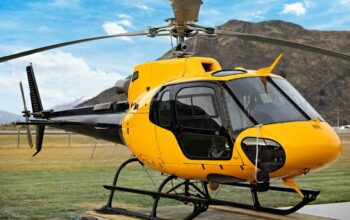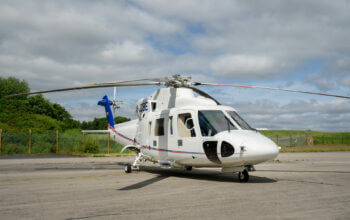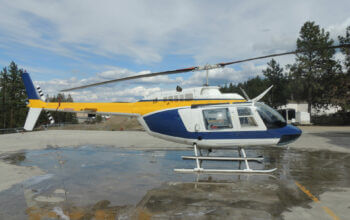Established in 1991, Spectrum Aeromed has designed and developed air ambulance medical interiors for hospital programs, military branches around the world, multi-mission charters and private operators. It has also created custom VIP emergency medical interior suites for executive aircraft and heads of state.

All products are made at the company’s 17,000-square-foot, state-of-the-art facility at Fargo, North Dakota’s Hector International Airport, by highly skilled designers and technicians.
“We’re the small, personal service company with a big company mindset and capabilities,” said Ricky Reno, Spectrum Aeromed’s vice president, military and government initiatives. “When it comes to providing the finest quality air medical suites at competitive prices, Spectrum Aeromed is at the top of its class.”
The company also achieves its promised delivery dates 98 percent of the time. In the helicopter industry, where delays are a way of business life, this is an astounding achievement.
As a small company, Spectrum Aeromed is nimble and fast to react. There are no big bureaucracies to wade through, as customers try to get things done. Yet the quality of products the company offers–either as standard packages adaptable to many airframes or full custom installations — rivals anything offered by Spectrum Aeromed’s largest competitors.

Worth noting: Spectrum Aeromed has over 70 supplemental type certificates (STCs) applying to nearly 400 aircraft. This means the air medical interior that fits your particular helicopter has likely already been Federal Aviation Administration (FAA) approved.
Spectrum Aeromed’s flagship air medical suite is its 2800 Series. “This module is extremely versatile, and has numerous STCs for fixed- and rotor-wing aircraft,” said Reno. “The 2800 system is lightweight, compact and fits smaller aircraft, yet has critical care capabilities for larger aircraft as well. The 2800’s functional, durable design provides years of problem-free service for your air ambulance program, and can be installed in single- or multiple-patient configurations depending on cabin space.”

The 2800 Series comes with a range of important air medical capabilities as standard features, which include dual supply outlets for oxygen, medical air, and vacuum; four IV mounts; and a wiring harness and master panel breaker (relay if required). The 2800’s stretcher fabric is flame retardant, easy to clean and can be custom colored.
Meanwhile, the system’s unique seat rail adapter allows for quick and easy conversion of the aircraft from executive to emergency medical services (EMS) configuration in approximately 15 minutes.
“Patient monitoring devices and medical equipment can be secured to the 2800 using different models of equipment tables, bridges, and IV poles,” said Reno. “The 2800’s overhead/medwall supply panel is movable along the length of the patient, or fully removable. It comes with an exam light and second set of pneumatic outlets, keeping aisles free from clutter and equipment.”

Spectrum Aeromed’s 2800 can be configured to secure a stretcher for adult patients, or an infant transport deck for securing an incubator and cylinder housing for neonatal patients.
The company’s 20/2200 system is designed for aircraft too small to house the 2800 air medical suite. “We call the 20/2200 module the ‘shortbox,'” said Reno. “It is especially suited for aircraft with limited floor space and can be configured for single- or multiple-patient transport.”
The 2200’s stretcher is specially designed with tapered corners to allow it to fit through narrow doors, or aircraft with cabinets that restrict the stretcher’s turning radius when loading or unloading.

“The short module base, which is unique to Spectrum Aeromed, contains all the components for critical care transports in a compact form,” Reno said. “It is just 48 inches long by 17 inches wide and 10 inches high.”
Spectrum Aeromed’s lightweight articulating stretcher deck is easy to remove and maintain. “It provides one-hand movement for patients up to 400 pounds (181 kilograms),” said Reno. “The stretcher pivots from full extension outside the aircraft to a locked position inside, completely eliminating the need for heavy lifting on the part of your crew.”
The quality, durability and price of Spectrum Aeromed’s air medical equipment have made it the choice of both civilian and military helicopter operators.
“We have equipped everything from AgustaWestland AW109s, Airbus Helicopter AS332 and AS350s; Bell 205, 212, 407, and 412s; and Sikorsky S-76s to large AW101s and S-92s,” said Reno. “We are currently working on an air medical STC for the Bell 429, and will continue to develop more STCs for other helicopters as they come to market. People want to use our air medical suites, and we do our best to make that possible.”
The bottom line: For high quality, durable air medical suites at a reasonable price and delivered 98 percent on time–98 percent!–Spectrum Aeromed is a helicopter operator’s logical choice.
“This is what we do, and all we do,” said Reno. “This is why Spectrum Aeromed puts so much effort into our air medical suites–and it shows.”
701-235-5478
If you would like to see your company featured in Insight, contact sales director Frank Sargeant at frank@mhmpub.com.









